Military Force and Counterterrorism
VerifiedAdded on 2022/10/10
|9
|2230
|300
AI Summary
This article discusses the roles that military forces can play in preventing the occurrence of terrorism, including deterrence, interception, training, hostage rescue, intelligence gathering, and retaliation attacks. The military has to deter further terrorist attacks through patrolling and erecting checkpoints in key areas. Additionally, the military can intercept weaponry and other logistics being shipped to terrorist zones. Training and resource sharing are also another method through which the militaries from around the world can use to collectively combat terrorism. Additionally, the military has to assimilate to new ways of intelligence gathering through clandestine and reconnaissance operations to capture the terrorist. These new methods will enable the military forces to overpower activities of terrorism.
Contribute Materials
Your contribution can guide someone’s learning journey. Share your
documents today.
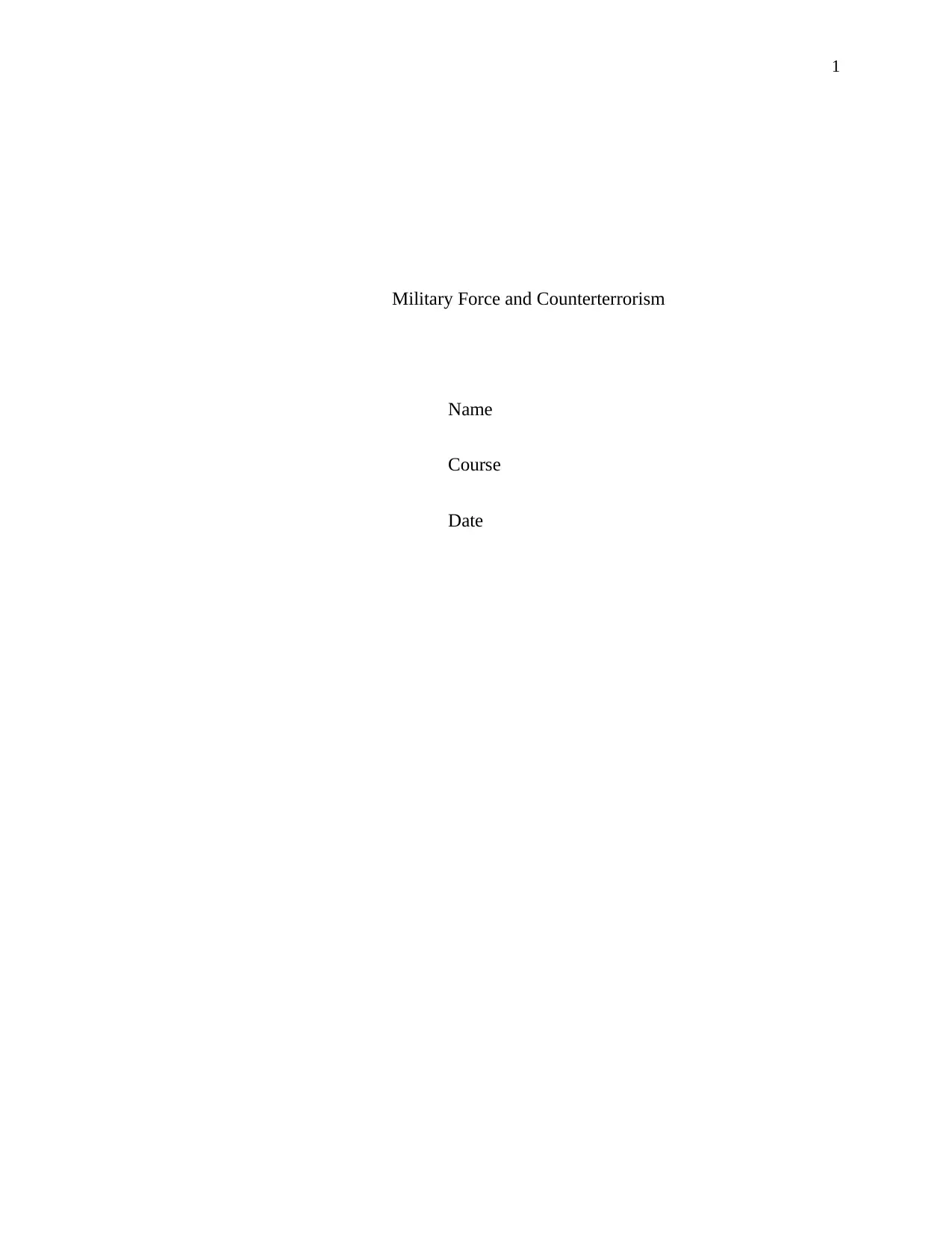
1
Military Force and Counterterrorism
Name
Course
Date
Military Force and Counterterrorism
Name
Course
Date
Secure Best Marks with AI Grader
Need help grading? Try our AI Grader for instant feedback on your assignments.
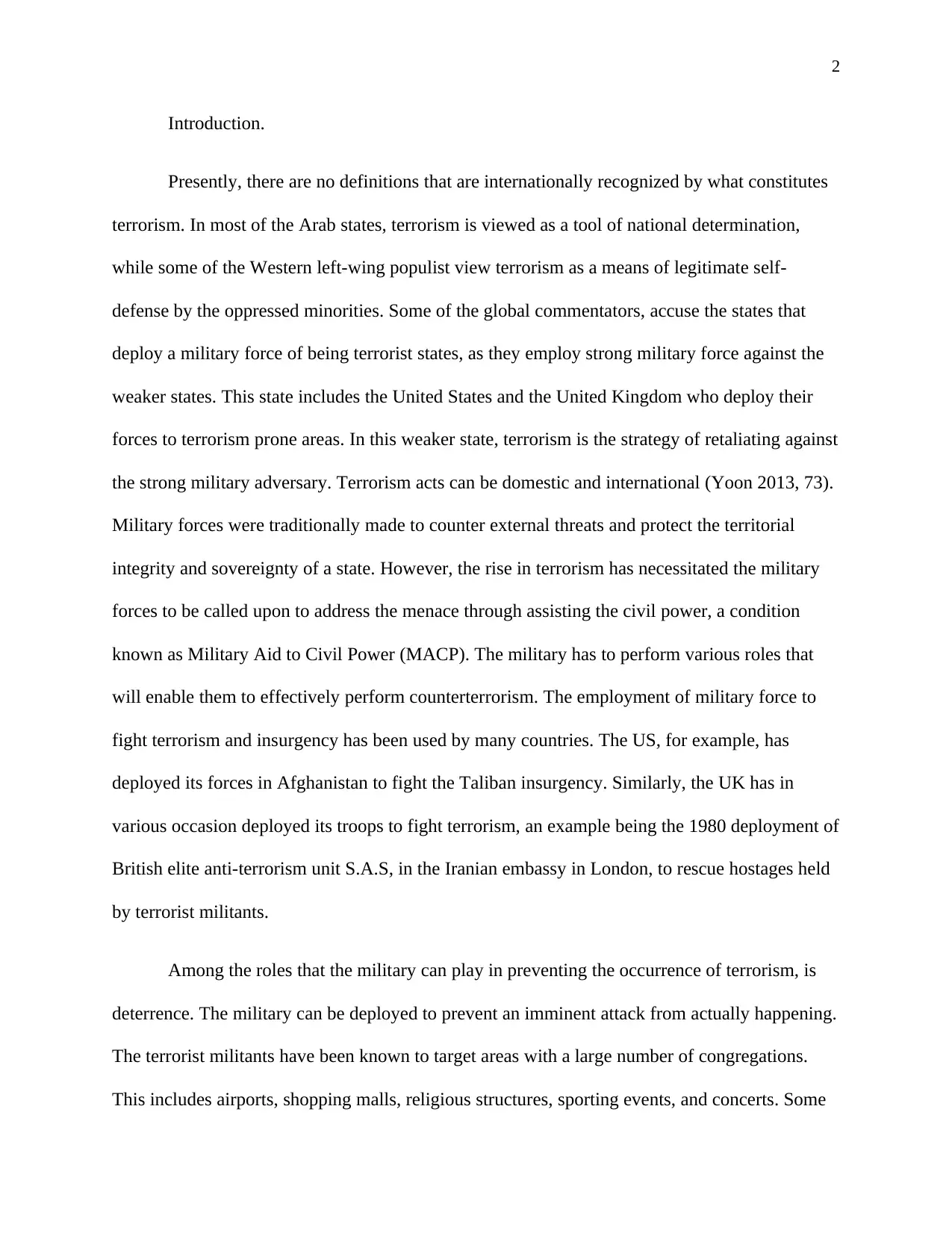
2
Introduction.
Presently, there are no definitions that are internationally recognized by what constitutes
terrorism. In most of the Arab states, terrorism is viewed as a tool of national determination,
while some of the Western left-wing populist view terrorism as a means of legitimate self-
defense by the oppressed minorities. Some of the global commentators, accuse the states that
deploy a military force of being terrorist states, as they employ strong military force against the
weaker states. This state includes the United States and the United Kingdom who deploy their
forces to terrorism prone areas. In this weaker state, terrorism is the strategy of retaliating against
the strong military adversary. Terrorism acts can be domestic and international (Yoon 2013, 73).
Military forces were traditionally made to counter external threats and protect the territorial
integrity and sovereignty of a state. However, the rise in terrorism has necessitated the military
forces to be called upon to address the menace through assisting the civil power, a condition
known as Military Aid to Civil Power (MACP). The military has to perform various roles that
will enable them to effectively perform counterterrorism. The employment of military force to
fight terrorism and insurgency has been used by many countries. The US, for example, has
deployed its forces in Afghanistan to fight the Taliban insurgency. Similarly, the UK has in
various occasion deployed its troops to fight terrorism, an example being the 1980 deployment of
British elite anti-terrorism unit S.A.S, in the Iranian embassy in London, to rescue hostages held
by terrorist militants.
Among the roles that the military can play in preventing the occurrence of terrorism, is
deterrence. The military can be deployed to prevent an imminent attack from actually happening.
The terrorist militants have been known to target areas with a large number of congregations.
This includes airports, shopping malls, religious structures, sporting events, and concerts. Some
Introduction.
Presently, there are no definitions that are internationally recognized by what constitutes
terrorism. In most of the Arab states, terrorism is viewed as a tool of national determination,
while some of the Western left-wing populist view terrorism as a means of legitimate self-
defense by the oppressed minorities. Some of the global commentators, accuse the states that
deploy a military force of being terrorist states, as they employ strong military force against the
weaker states. This state includes the United States and the United Kingdom who deploy their
forces to terrorism prone areas. In this weaker state, terrorism is the strategy of retaliating against
the strong military adversary. Terrorism acts can be domestic and international (Yoon 2013, 73).
Military forces were traditionally made to counter external threats and protect the territorial
integrity and sovereignty of a state. However, the rise in terrorism has necessitated the military
forces to be called upon to address the menace through assisting the civil power, a condition
known as Military Aid to Civil Power (MACP). The military has to perform various roles that
will enable them to effectively perform counterterrorism. The employment of military force to
fight terrorism and insurgency has been used by many countries. The US, for example, has
deployed its forces in Afghanistan to fight the Taliban insurgency. Similarly, the UK has in
various occasion deployed its troops to fight terrorism, an example being the 1980 deployment of
British elite anti-terrorism unit S.A.S, in the Iranian embassy in London, to rescue hostages held
by terrorist militants.
Among the roles that the military can play in preventing the occurrence of terrorism, is
deterrence. The military can be deployed to prevent an imminent attack from actually happening.
The terrorist militants have been known to target areas with a large number of congregations.
This includes airports, shopping malls, religious structures, sporting events, and concerts. Some
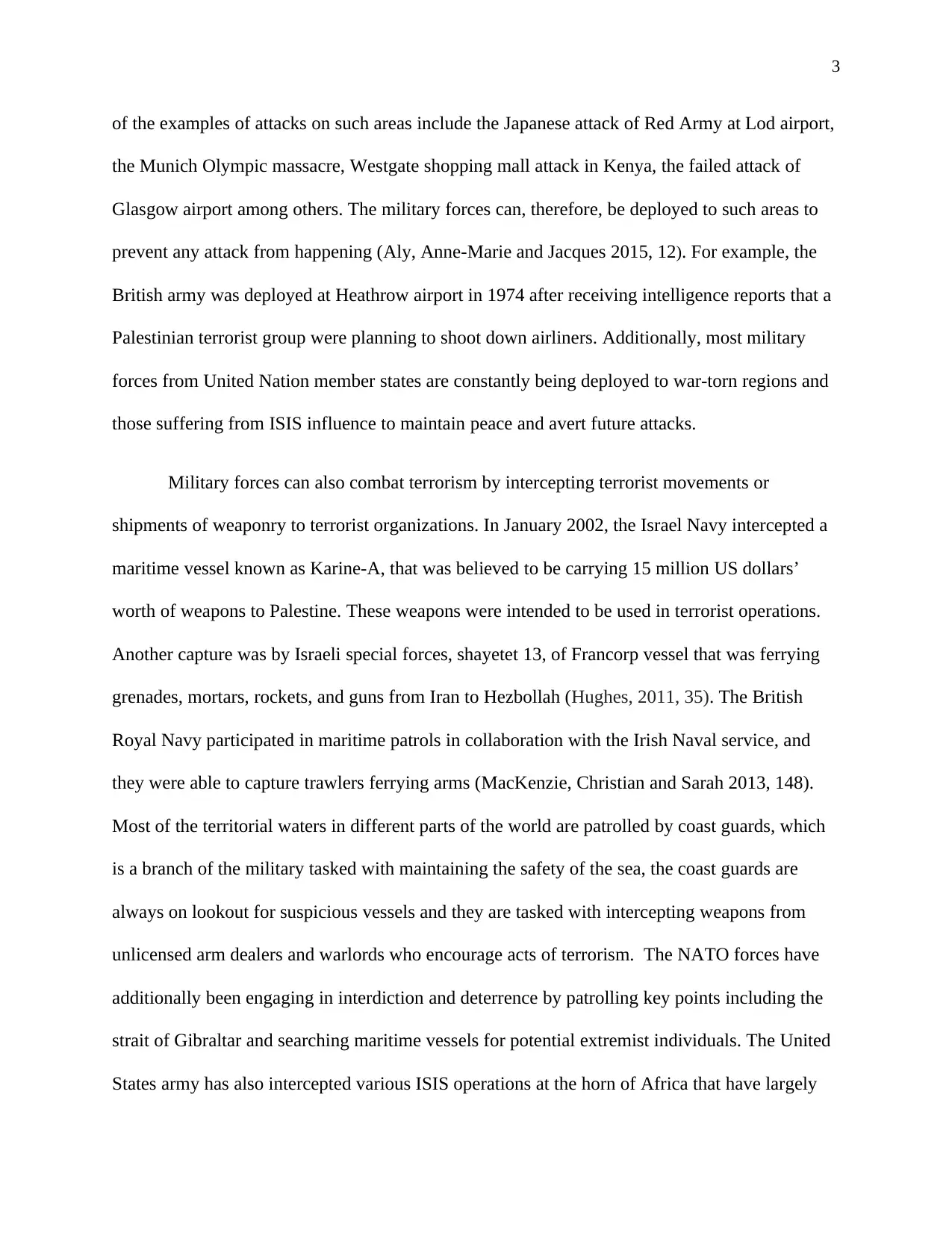
3
of the examples of attacks on such areas include the Japanese attack of Red Army at Lod airport,
the Munich Olympic massacre, Westgate shopping mall attack in Kenya, the failed attack of
Glasgow airport among others. The military forces can, therefore, be deployed to such areas to
prevent any attack from happening (Aly, Anne-Marie and Jacques 2015, 12). For example, the
British army was deployed at Heathrow airport in 1974 after receiving intelligence reports that a
Palestinian terrorist group were planning to shoot down airliners. Additionally, most military
forces from United Nation member states are constantly being deployed to war-torn regions and
those suffering from ISIS influence to maintain peace and avert future attacks.
Military forces can also combat terrorism by intercepting terrorist movements or
shipments of weaponry to terrorist organizations. In January 2002, the Israel Navy intercepted a
maritime vessel known as Karine-A, that was believed to be carrying 15 million US dollars’
worth of weapons to Palestine. These weapons were intended to be used in terrorist operations.
Another capture was by Israeli special forces, shayetet 13, of Francorp vessel that was ferrying
grenades, mortars, rockets, and guns from Iran to Hezbollah (Hughes, 2011, 35). The British
Royal Navy participated in maritime patrols in collaboration with the Irish Naval service, and
they were able to capture trawlers ferrying arms (MacKenzie, Christian and Sarah 2013, 148).
Most of the territorial waters in different parts of the world are patrolled by coast guards, which
is a branch of the military tasked with maintaining the safety of the sea, the coast guards are
always on lookout for suspicious vessels and they are tasked with intercepting weapons from
unlicensed arm dealers and warlords who encourage acts of terrorism. The NATO forces have
additionally been engaging in interdiction and deterrence by patrolling key points including the
strait of Gibraltar and searching maritime vessels for potential extremist individuals. The United
States army has also intercepted various ISIS operations at the horn of Africa that have largely
of the examples of attacks on such areas include the Japanese attack of Red Army at Lod airport,
the Munich Olympic massacre, Westgate shopping mall attack in Kenya, the failed attack of
Glasgow airport among others. The military forces can, therefore, be deployed to such areas to
prevent any attack from happening (Aly, Anne-Marie and Jacques 2015, 12). For example, the
British army was deployed at Heathrow airport in 1974 after receiving intelligence reports that a
Palestinian terrorist group were planning to shoot down airliners. Additionally, most military
forces from United Nation member states are constantly being deployed to war-torn regions and
those suffering from ISIS influence to maintain peace and avert future attacks.
Military forces can also combat terrorism by intercepting terrorist movements or
shipments of weaponry to terrorist organizations. In January 2002, the Israel Navy intercepted a
maritime vessel known as Karine-A, that was believed to be carrying 15 million US dollars’
worth of weapons to Palestine. These weapons were intended to be used in terrorist operations.
Another capture was by Israeli special forces, shayetet 13, of Francorp vessel that was ferrying
grenades, mortars, rockets, and guns from Iran to Hezbollah (Hughes, 2011, 35). The British
Royal Navy participated in maritime patrols in collaboration with the Irish Naval service, and
they were able to capture trawlers ferrying arms (MacKenzie, Christian and Sarah 2013, 148).
Most of the territorial waters in different parts of the world are patrolled by coast guards, which
is a branch of the military tasked with maintaining the safety of the sea, the coast guards are
always on lookout for suspicious vessels and they are tasked with intercepting weapons from
unlicensed arm dealers and warlords who encourage acts of terrorism. The NATO forces have
additionally been engaging in interdiction and deterrence by patrolling key points including the
strait of Gibraltar and searching maritime vessels for potential extremist individuals. The United
States army has also intercepted various ISIS operations at the horn of Africa that have largely
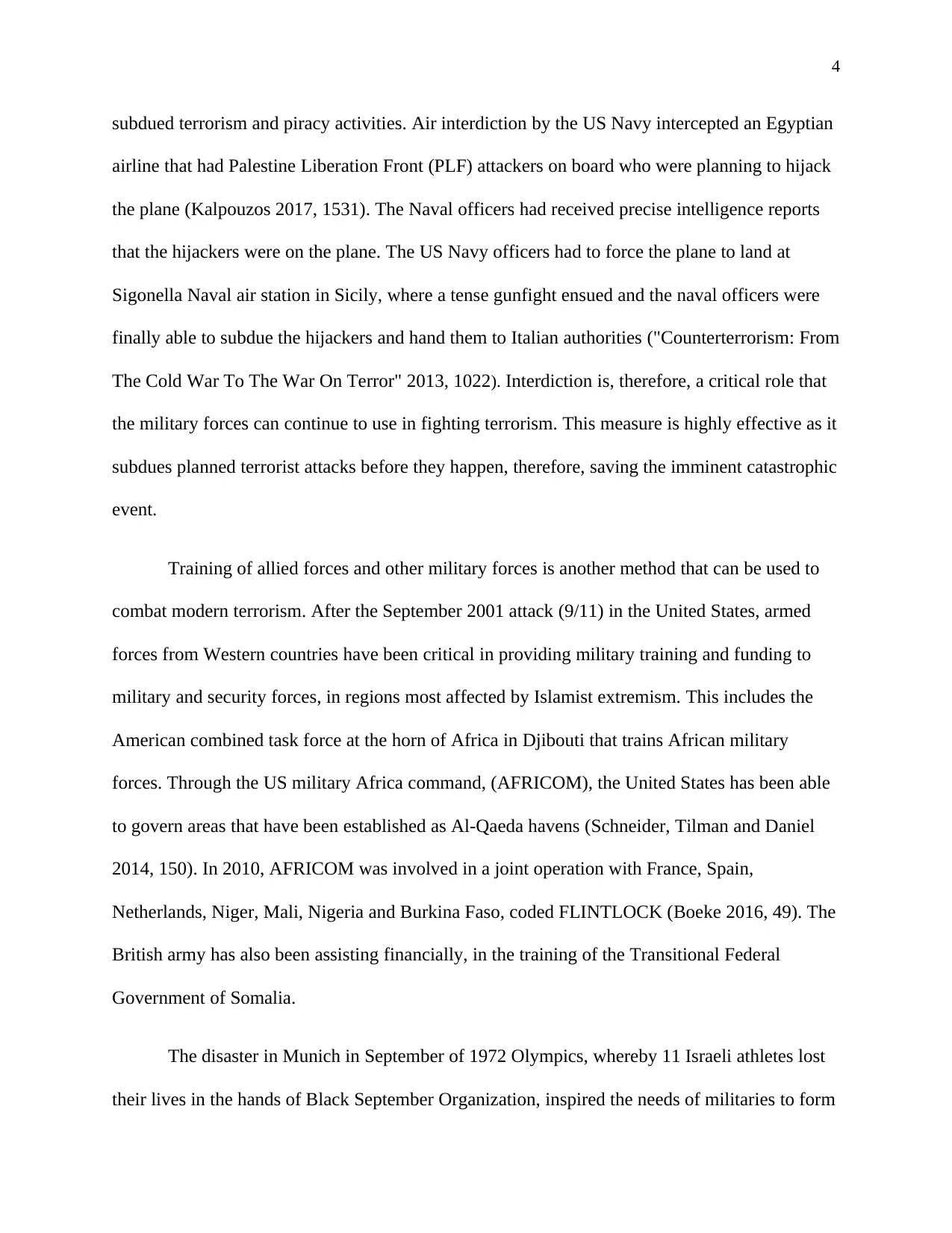
4
subdued terrorism and piracy activities. Air interdiction by the US Navy intercepted an Egyptian
airline that had Palestine Liberation Front (PLF) attackers on board who were planning to hijack
the plane (Kalpouzos 2017, 1531). The Naval officers had received precise intelligence reports
that the hijackers were on the plane. The US Navy officers had to force the plane to land at
Sigonella Naval air station in Sicily, where a tense gunfight ensued and the naval officers were
finally able to subdue the hijackers and hand them to Italian authorities ("Counterterrorism: From
The Cold War To The War On Terror" 2013, 1022). Interdiction is, therefore, a critical role that
the military forces can continue to use in fighting terrorism. This measure is highly effective as it
subdues planned terrorist attacks before they happen, therefore, saving the imminent catastrophic
event.
Training of allied forces and other military forces is another method that can be used to
combat modern terrorism. After the September 2001 attack (9/11) in the United States, armed
forces from Western countries have been critical in providing military training and funding to
military and security forces, in regions most affected by Islamist extremism. This includes the
American combined task force at the horn of Africa in Djibouti that trains African military
forces. Through the US military Africa command, (AFRICOM), the United States has been able
to govern areas that have been established as Al-Qaeda havens (Schneider, Tilman and Daniel
2014, 150). In 2010, AFRICOM was involved in a joint operation with France, Spain,
Netherlands, Niger, Mali, Nigeria and Burkina Faso, coded FLINTLOCK (Boeke 2016, 49). The
British army has also been assisting financially, in the training of the Transitional Federal
Government of Somalia.
The disaster in Munich in September of 1972 Olympics, whereby 11 Israeli athletes lost
their lives in the hands of Black September Organization, inspired the needs of militaries to form
subdued terrorism and piracy activities. Air interdiction by the US Navy intercepted an Egyptian
airline that had Palestine Liberation Front (PLF) attackers on board who were planning to hijack
the plane (Kalpouzos 2017, 1531). The Naval officers had received precise intelligence reports
that the hijackers were on the plane. The US Navy officers had to force the plane to land at
Sigonella Naval air station in Sicily, where a tense gunfight ensued and the naval officers were
finally able to subdue the hijackers and hand them to Italian authorities ("Counterterrorism: From
The Cold War To The War On Terror" 2013, 1022). Interdiction is, therefore, a critical role that
the military forces can continue to use in fighting terrorism. This measure is highly effective as it
subdues planned terrorist attacks before they happen, therefore, saving the imminent catastrophic
event.
Training of allied forces and other military forces is another method that can be used to
combat modern terrorism. After the September 2001 attack (9/11) in the United States, armed
forces from Western countries have been critical in providing military training and funding to
military and security forces, in regions most affected by Islamist extremism. This includes the
American combined task force at the horn of Africa in Djibouti that trains African military
forces. Through the US military Africa command, (AFRICOM), the United States has been able
to govern areas that have been established as Al-Qaeda havens (Schneider, Tilman and Daniel
2014, 150). In 2010, AFRICOM was involved in a joint operation with France, Spain,
Netherlands, Niger, Mali, Nigeria and Burkina Faso, coded FLINTLOCK (Boeke 2016, 49). The
British army has also been assisting financially, in the training of the Transitional Federal
Government of Somalia.
The disaster in Munich in September of 1972 Olympics, whereby 11 Israeli athletes lost
their lives in the hands of Black September Organization, inspired the needs of militaries to form
Secure Best Marks with AI Grader
Need help grading? Try our AI Grader for instant feedback on your assignments.
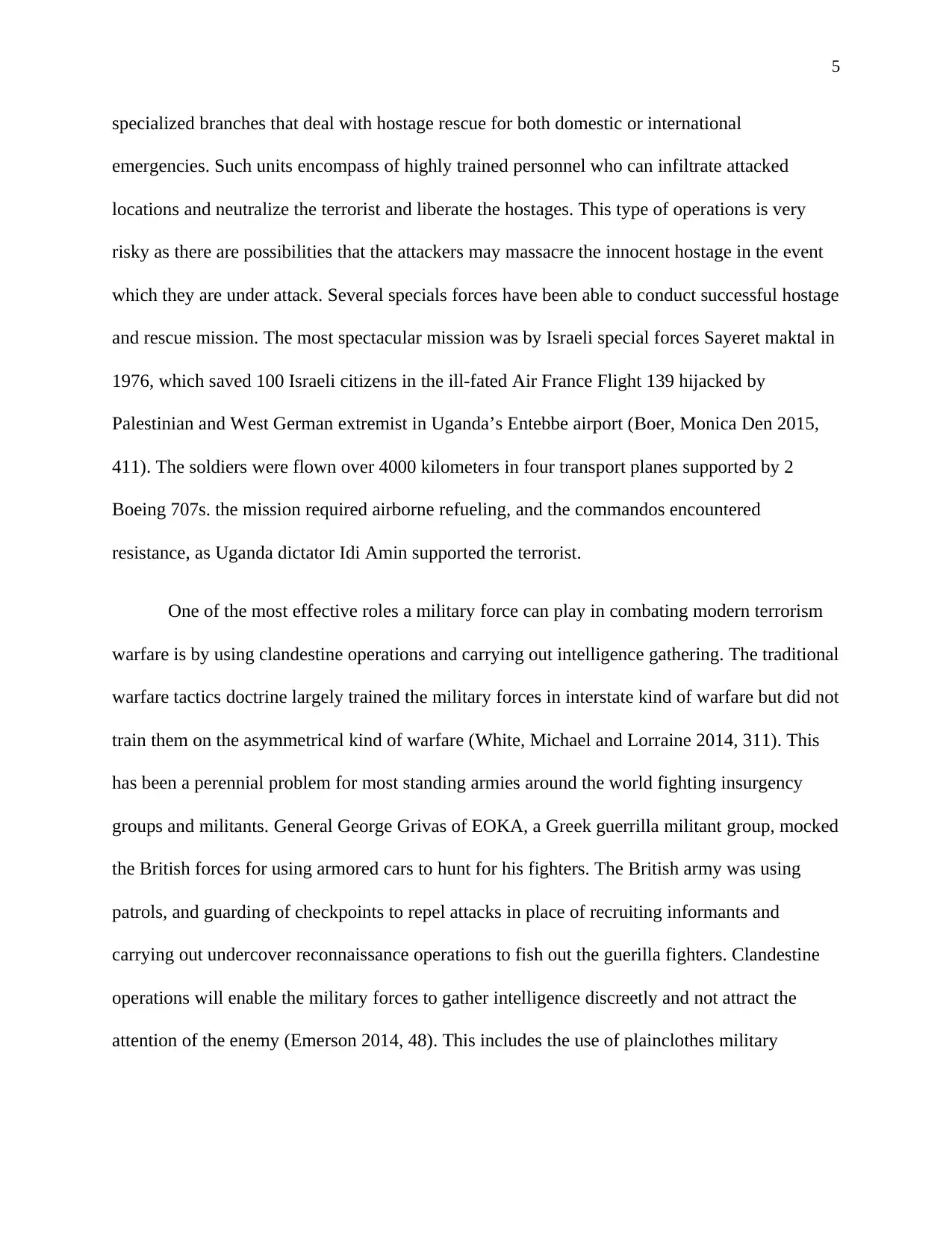
5
specialized branches that deal with hostage rescue for both domestic or international
emergencies. Such units encompass of highly trained personnel who can infiltrate attacked
locations and neutralize the terrorist and liberate the hostages. This type of operations is very
risky as there are possibilities that the attackers may massacre the innocent hostage in the event
which they are under attack. Several specials forces have been able to conduct successful hostage
and rescue mission. The most spectacular mission was by Israeli special forces Sayeret maktal in
1976, which saved 100 Israeli citizens in the ill-fated Air France Flight 139 hijacked by
Palestinian and West German extremist in Uganda’s Entebbe airport (Boer, Monica Den 2015,
411). The soldiers were flown over 4000 kilometers in four transport planes supported by 2
Boeing 707s. the mission required airborne refueling, and the commandos encountered
resistance, as Uganda dictator Idi Amin supported the terrorist.
One of the most effective roles a military force can play in combating modern terrorism
warfare is by using clandestine operations and carrying out intelligence gathering. The traditional
warfare tactics doctrine largely trained the military forces in interstate kind of warfare but did not
train them on the asymmetrical kind of warfare (White, Michael and Lorraine 2014, 311). This
has been a perennial problem for most standing armies around the world fighting insurgency
groups and militants. General George Grivas of EOKA, a Greek guerrilla militant group, mocked
the British forces for using armored cars to hunt for his fighters. The British army was using
patrols, and guarding of checkpoints to repel attacks in place of recruiting informants and
carrying out undercover reconnaissance operations to fish out the guerilla fighters. Clandestine
operations will enable the military forces to gather intelligence discreetly and not attract the
attention of the enemy (Emerson 2014, 48). This includes the use of plainclothes military
specialized branches that deal with hostage rescue for both domestic or international
emergencies. Such units encompass of highly trained personnel who can infiltrate attacked
locations and neutralize the terrorist and liberate the hostages. This type of operations is very
risky as there are possibilities that the attackers may massacre the innocent hostage in the event
which they are under attack. Several specials forces have been able to conduct successful hostage
and rescue mission. The most spectacular mission was by Israeli special forces Sayeret maktal in
1976, which saved 100 Israeli citizens in the ill-fated Air France Flight 139 hijacked by
Palestinian and West German extremist in Uganda’s Entebbe airport (Boer, Monica Den 2015,
411). The soldiers were flown over 4000 kilometers in four transport planes supported by 2
Boeing 707s. the mission required airborne refueling, and the commandos encountered
resistance, as Uganda dictator Idi Amin supported the terrorist.
One of the most effective roles a military force can play in combating modern terrorism
warfare is by using clandestine operations and carrying out intelligence gathering. The traditional
warfare tactics doctrine largely trained the military forces in interstate kind of warfare but did not
train them on the asymmetrical kind of warfare (White, Michael and Lorraine 2014, 311). This
has been a perennial problem for most standing armies around the world fighting insurgency
groups and militants. General George Grivas of EOKA, a Greek guerrilla militant group, mocked
the British forces for using armored cars to hunt for his fighters. The British army was using
patrols, and guarding of checkpoints to repel attacks in place of recruiting informants and
carrying out undercover reconnaissance operations to fish out the guerilla fighters. Clandestine
operations will enable the military forces to gather intelligence discreetly and not attract the
attention of the enemy (Emerson 2014, 48). This includes the use of plainclothes military
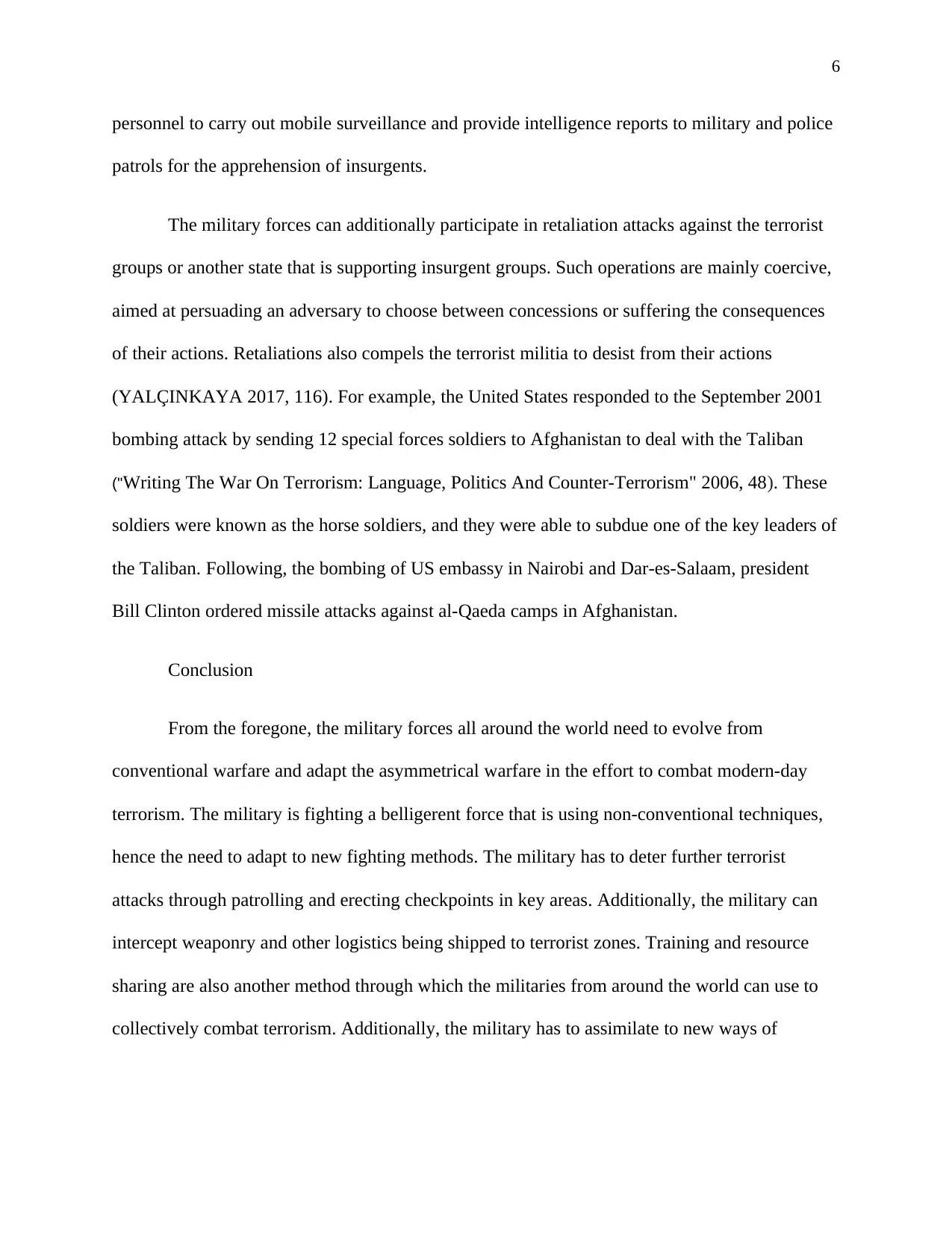
6
personnel to carry out mobile surveillance and provide intelligence reports to military and police
patrols for the apprehension of insurgents.
The military forces can additionally participate in retaliation attacks against the terrorist
groups or another state that is supporting insurgent groups. Such operations are mainly coercive,
aimed at persuading an adversary to choose between concessions or suffering the consequences
of their actions. Retaliations also compels the terrorist militia to desist from their actions
(YALÇINKAYA 2017, 116). For example, the United States responded to the September 2001
bombing attack by sending 12 special forces soldiers to Afghanistan to deal with the Taliban
("Writing The War On Terrorism: Language, Politics And Counter-Terrorism" 2006, 48). These
soldiers were known as the horse soldiers, and they were able to subdue one of the key leaders of
the Taliban. Following, the bombing of US embassy in Nairobi and Dar-es-Salaam, president
Bill Clinton ordered missile attacks against al-Qaeda camps in Afghanistan.
Conclusion
From the foregone, the military forces all around the world need to evolve from
conventional warfare and adapt the asymmetrical warfare in the effort to combat modern-day
terrorism. The military is fighting a belligerent force that is using non-conventional techniques,
hence the need to adapt to new fighting methods. The military has to deter further terrorist
attacks through patrolling and erecting checkpoints in key areas. Additionally, the military can
intercept weaponry and other logistics being shipped to terrorist zones. Training and resource
sharing are also another method through which the militaries from around the world can use to
collectively combat terrorism. Additionally, the military has to assimilate to new ways of
personnel to carry out mobile surveillance and provide intelligence reports to military and police
patrols for the apprehension of insurgents.
The military forces can additionally participate in retaliation attacks against the terrorist
groups or another state that is supporting insurgent groups. Such operations are mainly coercive,
aimed at persuading an adversary to choose between concessions or suffering the consequences
of their actions. Retaliations also compels the terrorist militia to desist from their actions
(YALÇINKAYA 2017, 116). For example, the United States responded to the September 2001
bombing attack by sending 12 special forces soldiers to Afghanistan to deal with the Taliban
("Writing The War On Terrorism: Language, Politics And Counter-Terrorism" 2006, 48). These
soldiers were known as the horse soldiers, and they were able to subdue one of the key leaders of
the Taliban. Following, the bombing of US embassy in Nairobi and Dar-es-Salaam, president
Bill Clinton ordered missile attacks against al-Qaeda camps in Afghanistan.
Conclusion
From the foregone, the military forces all around the world need to evolve from
conventional warfare and adapt the asymmetrical warfare in the effort to combat modern-day
terrorism. The military is fighting a belligerent force that is using non-conventional techniques,
hence the need to adapt to new fighting methods. The military has to deter further terrorist
attacks through patrolling and erecting checkpoints in key areas. Additionally, the military can
intercept weaponry and other logistics being shipped to terrorist zones. Training and resource
sharing are also another method through which the militaries from around the world can use to
collectively combat terrorism. Additionally, the military has to assimilate to new ways of
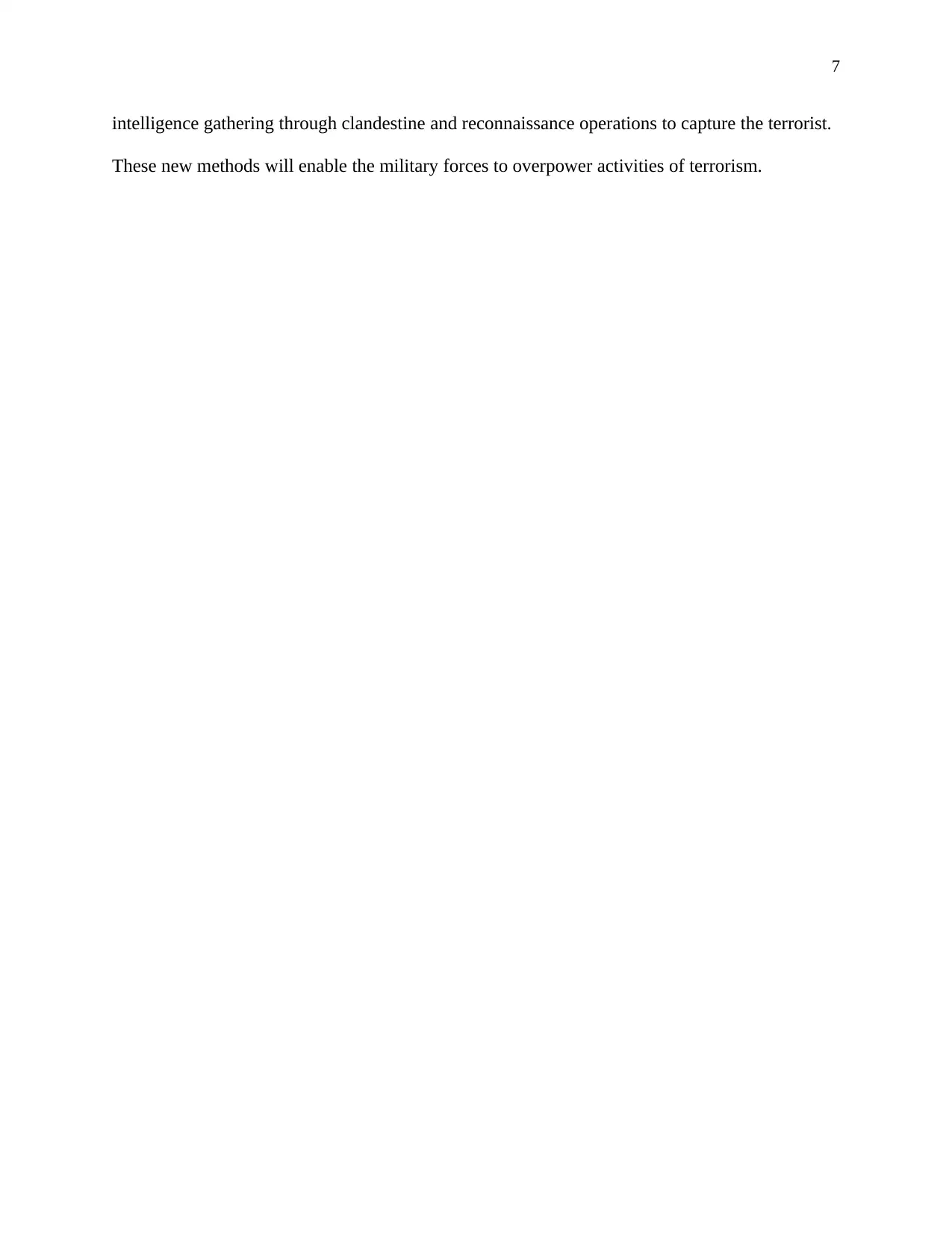
7
intelligence gathering through clandestine and reconnaissance operations to capture the terrorist.
These new methods will enable the military forces to overpower activities of terrorism.
intelligence gathering through clandestine and reconnaissance operations to capture the terrorist.
These new methods will enable the military forces to overpower activities of terrorism.
Paraphrase This Document
Need a fresh take? Get an instant paraphrase of this document with our AI Paraphraser
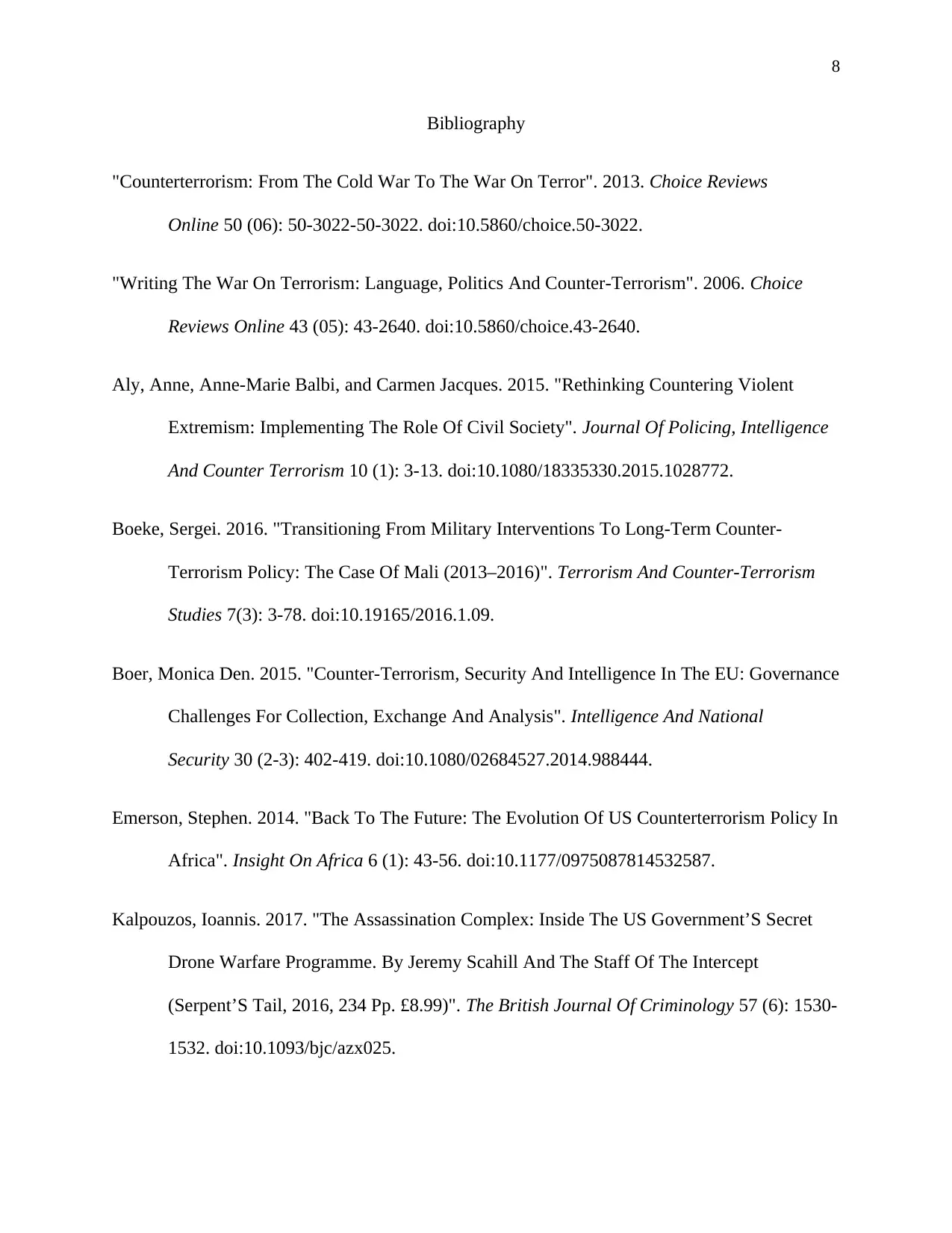
8
Bibliography
"Counterterrorism: From The Cold War To The War On Terror". 2013. Choice Reviews
Online 50 (06): 50-3022-50-3022. doi:10.5860/choice.50-3022.
"Writing The War On Terrorism: Language, Politics And Counter-Terrorism". 2006. Choice
Reviews Online 43 (05): 43-2640. doi:10.5860/choice.43-2640.
Aly, Anne, Anne-Marie Balbi, and Carmen Jacques. 2015. "Rethinking Countering Violent
Extremism: Implementing The Role Of Civil Society". Journal Of Policing, Intelligence
And Counter Terrorism 10 (1): 3-13. doi:10.1080/18335330.2015.1028772.
Boeke, Sergei. 2016. "Transitioning From Military Interventions To Long-Term Counter-
Terrorism Policy: The Case Of Mali (2013–2016)". Terrorism And Counter-Terrorism
Studies 7(3): 3-78. doi:10.19165/2016.1.09.
Boer, Monica Den. 2015. "Counter-Terrorism, Security And Intelligence In The EU: Governance
Challenges For Collection, Exchange And Analysis". Intelligence And National
Security 30 (2-3): 402-419. doi:10.1080/02684527.2014.988444.
Emerson, Stephen. 2014. "Back To The Future: The Evolution Of US Counterterrorism Policy In
Africa". Insight On Africa 6 (1): 43-56. doi:10.1177/0975087814532587.
Kalpouzos, Ioannis. 2017. "The Assassination Complex: Inside The US Government’S Secret
Drone Warfare Programme. By Jeremy Scahill And The Staff Of The Intercept
(Serpent’S Tail, 2016, 234 Pp. £8.99)". The British Journal Of Criminology 57 (6): 1530-
1532. doi:10.1093/bjc/azx025.
Bibliography
"Counterterrorism: From The Cold War To The War On Terror". 2013. Choice Reviews
Online 50 (06): 50-3022-50-3022. doi:10.5860/choice.50-3022.
"Writing The War On Terrorism: Language, Politics And Counter-Terrorism". 2006. Choice
Reviews Online 43 (05): 43-2640. doi:10.5860/choice.43-2640.
Aly, Anne, Anne-Marie Balbi, and Carmen Jacques. 2015. "Rethinking Countering Violent
Extremism: Implementing The Role Of Civil Society". Journal Of Policing, Intelligence
And Counter Terrorism 10 (1): 3-13. doi:10.1080/18335330.2015.1028772.
Boeke, Sergei. 2016. "Transitioning From Military Interventions To Long-Term Counter-
Terrorism Policy: The Case Of Mali (2013–2016)". Terrorism And Counter-Terrorism
Studies 7(3): 3-78. doi:10.19165/2016.1.09.
Boer, Monica Den. 2015. "Counter-Terrorism, Security And Intelligence In The EU: Governance
Challenges For Collection, Exchange And Analysis". Intelligence And National
Security 30 (2-3): 402-419. doi:10.1080/02684527.2014.988444.
Emerson, Stephen. 2014. "Back To The Future: The Evolution Of US Counterterrorism Policy In
Africa". Insight On Africa 6 (1): 43-56. doi:10.1177/0975087814532587.
Kalpouzos, Ioannis. 2017. "The Assassination Complex: Inside The US Government’S Secret
Drone Warfare Programme. By Jeremy Scahill And The Staff Of The Intercept
(Serpent’S Tail, 2016, 234 Pp. £8.99)". The British Journal Of Criminology 57 (6): 1530-
1532. doi:10.1093/bjc/azx025.
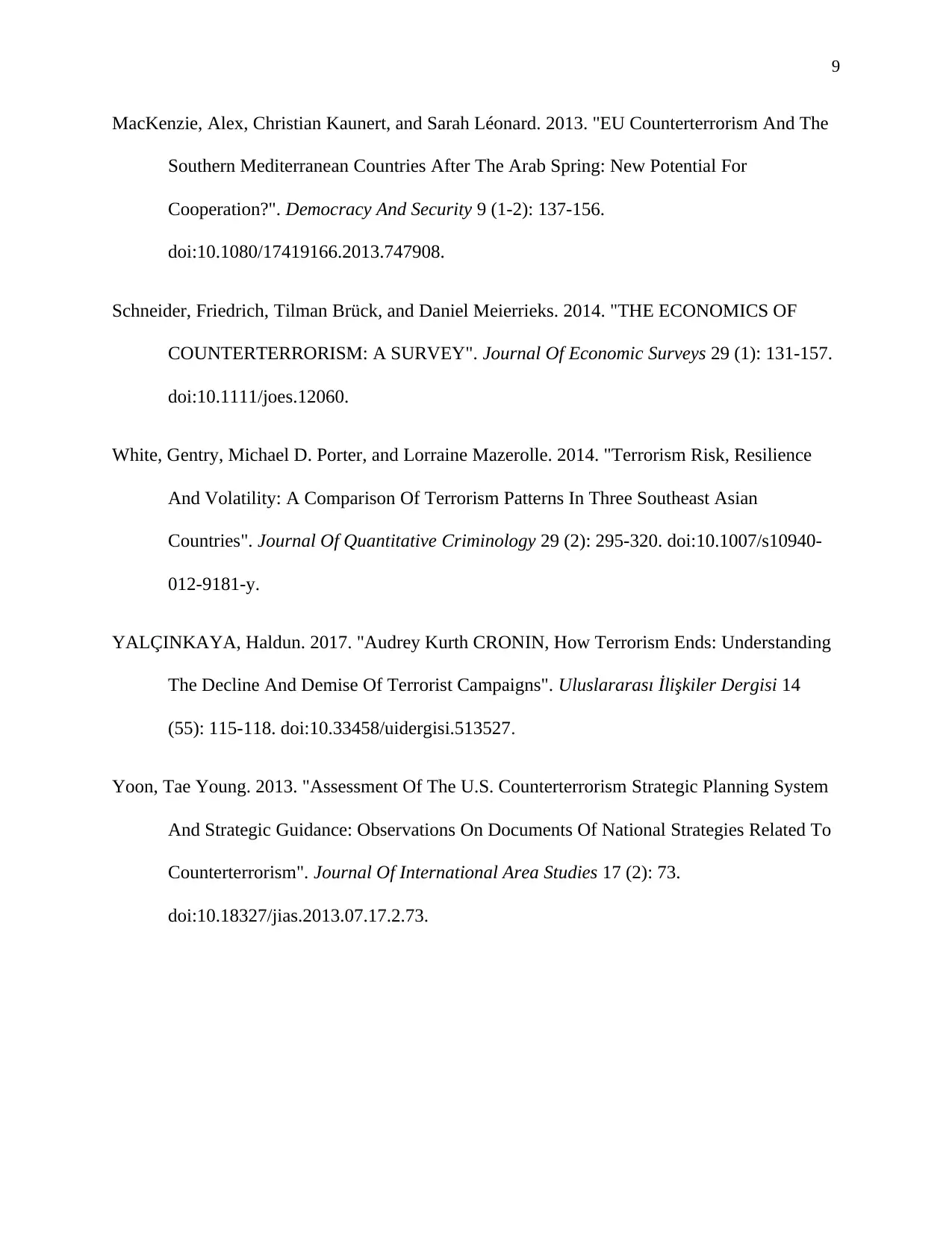
9
MacKenzie, Alex, Christian Kaunert, and Sarah Léonard. 2013. "EU Counterterrorism And The
Southern Mediterranean Countries After The Arab Spring: New Potential For
Cooperation?". Democracy And Security 9 (1-2): 137-156.
doi:10.1080/17419166.2013.747908.
Schneider, Friedrich, Tilman Brück, and Daniel Meierrieks. 2014. "THE ECONOMICS OF
COUNTERTERRORISM: A SURVEY". Journal Of Economic Surveys 29 (1): 131-157.
doi:10.1111/joes.12060.
White, Gentry, Michael D. Porter, and Lorraine Mazerolle. 2014. "Terrorism Risk, Resilience
And Volatility: A Comparison Of Terrorism Patterns In Three Southeast Asian
Countries". Journal Of Quantitative Criminology 29 (2): 295-320. doi:10.1007/s10940-
012-9181-y.
YALÇINKAYA, Haldun. 2017. "Audrey Kurth CRONIN, How Terrorism Ends: Understanding
The Decline And Demise Of Terrorist Campaigns". Uluslararası İlişkiler Dergisi 14
(55): 115-118. doi:10.33458/uidergisi.513527.
Yoon, Tae Young. 2013. "Assessment Of The U.S. Counterterrorism Strategic Planning System
And Strategic Guidance: Observations On Documents Of National Strategies Related To
Counterterrorism". Journal Of International Area Studies 17 (2): 73.
doi:10.18327/jias.2013.07.17.2.73.
MacKenzie, Alex, Christian Kaunert, and Sarah Léonard. 2013. "EU Counterterrorism And The
Southern Mediterranean Countries After The Arab Spring: New Potential For
Cooperation?". Democracy And Security 9 (1-2): 137-156.
doi:10.1080/17419166.2013.747908.
Schneider, Friedrich, Tilman Brück, and Daniel Meierrieks. 2014. "THE ECONOMICS OF
COUNTERTERRORISM: A SURVEY". Journal Of Economic Surveys 29 (1): 131-157.
doi:10.1111/joes.12060.
White, Gentry, Michael D. Porter, and Lorraine Mazerolle. 2014. "Terrorism Risk, Resilience
And Volatility: A Comparison Of Terrorism Patterns In Three Southeast Asian
Countries". Journal Of Quantitative Criminology 29 (2): 295-320. doi:10.1007/s10940-
012-9181-y.
YALÇINKAYA, Haldun. 2017. "Audrey Kurth CRONIN, How Terrorism Ends: Understanding
The Decline And Demise Of Terrorist Campaigns". Uluslararası İlişkiler Dergisi 14
(55): 115-118. doi:10.33458/uidergisi.513527.
Yoon, Tae Young. 2013. "Assessment Of The U.S. Counterterrorism Strategic Planning System
And Strategic Guidance: Observations On Documents Of National Strategies Related To
Counterterrorism". Journal Of International Area Studies 17 (2): 73.
doi:10.18327/jias.2013.07.17.2.73.
1 out of 9
Your All-in-One AI-Powered Toolkit for Academic Success.
+13062052269
info@desklib.com
Available 24*7 on WhatsApp / Email
![[object Object]](/_next/static/media/star-bottom.7253800d.svg)
Unlock your academic potential
© 2024 | Zucol Services PVT LTD | All rights reserved.

